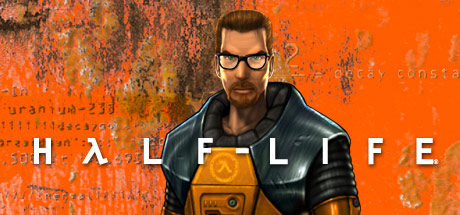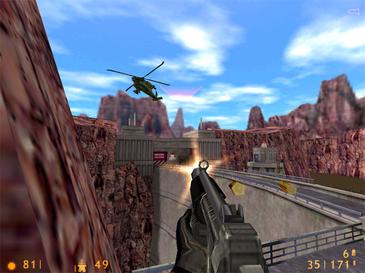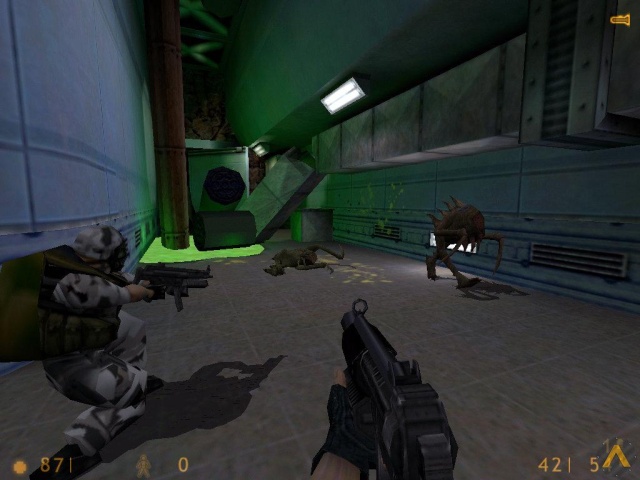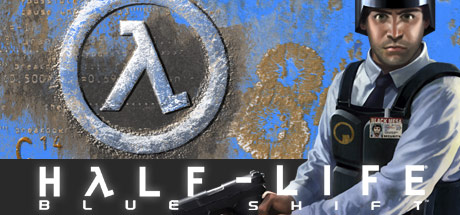http://cdn.akamai.steamstatic.com/steam/apps/70/header.jpg?t=1411592690
It's Half Life 2's 10th birthday in a few days, so today and tomorrow I'll be looking at both games in the series, as well as their expansion packs, and talking about why they were, and still are, some of the greatest shooters ever made. Today I'll be looking at the original Half Life, as well as touching on Opposing Forces and Blue Shift, two of it's expansion packs.
Doom clones
http://www.mygamesfile.com/halflifegamea/img/5l.jpg
Half Life features a variety of ways to kill whatever's in your way.
A friend of mine once asked me why the Half Life series was so important. This is a fair question since, at first glance, both games appear to just be run-of-the-mill shooters. You're a silent protagonist, you have guns, there's things that need shooting, all pretty standard. I think a lot of Half Life's importance comes from context, specifically the state of the industry and shooters in particular when the first game came out.
Shooters had been around for a while before Half Life was released. The most notable FPS was Wolfenstein back in 1992, but there's evidence of the genre even before that. 1993's Doom was really where shooters hit their mark, insofar as, for the longest time, FPS games were just refered to as "Doom clones" a not unfair moniker since that's exactly what they were. Every shooter was just another version of Doom, albiet with some stand outs like Duke Nukem 3d, Rise of the Triad, or Blood. They were all just mindless shooters that sent you through barely connected levels with little to no overarching plot. John Carmack co-founder of Id software and creator of Wolfenstein and Doom has famously said "Story in a game is like a story in a porn movie. It's expected to be there, but it's not that important." For the longest time that was the attitude, games, especially shooters, didn't need a plot as long as they were fun. Then someone opened the Valve.
1998
http://upload.wikimedia.org/wikipedia/en/6/65/Halflife_ingame.jpg
Gordon Freeman may be a man of science, but his skill with a gun is what keeps him alive.
Founded by ex-Microsoft employees Mike Harrington and Gabe Newell, Valve's first game was to be a sci-fi horror game based on the Unreal 2 engine, developed for Seirra Online. Based loosely around the setup from Stephen King's The Mist, the game centered around a military base that accidentally creates a portal to another dimension, ushering an apocalypse. After being shown at the 1997 E3 expo, the game was finally released in late 1998.
Half Life blew people away. For the first time, the player was given context for their action, and a reason to move forward other then "because that's where the enemies are". Half Life features no cut scenes, and it's protagonist Gordon Freeman never speaks, allowing the player to become fully immersed and imagine themselves as Gordon Freeman. There's no better example of this then the YouTube comedy series Mind of Freeman.
This was truly a far cry from other shooters at the time. People simply hadn't heard of a shooter having a plot, and scripted cinematic events weren't common in FPS. No a days this is common practice, with Battlefield or COD hedging their entire single player campaigns on big set piece moments, but back then it was fresh and new.
Graphically, the original Half Life doesn't quiet hold up. It's blocky, jagged, and low res, and it's lighting engine is a joke. There was a re-release onto the new Source engine a few years back that added several effects, but the real way to replay Half Life is through the fantastic Black Mesa fan made game. It's unfortunate that Black Mesa isn't complete, but it's free and the developers are promising a complete version soon.
It's worth talking about Half Life's main character Gordon Freeman. Like everything else in Half Life, Freeman is a break away from conventional gaming heroes. He's not a super soldier, a space marine, or even that good with a gun. Gordon Freeman is just a guy, with a hazard suit, and he just wants to survive. He's a scientist, driven by the desire to explain the unexplained, and when he accidentally creates the apocalypse, it's just because he's doing his job.
Opposing Forces
http://cdn.akamai.steamstatic.com/steam/apps/50/header.jpg?t=1414620270
A little over a year after Half Life's release an expansion pack called Opposing Forces came out. The title is apt, as you play as one of the many soldiers sent to kill Freeman and shut Black Mesa down. Everything goes awry fast and you end up stranded, fighting the aliens and trying to escape with everyone else.
Opposing Forces was something of a tonal shift from the original Half Life. Where as the vanilla game was largely about exploration with combat on top, Opposing Forces was a much more action oriented game, with constant gunfights every moment. To facilitate this is the expanded roster of weapons, as well as protagonist Adrian Shepard's ability to recruit soldiers to fight with him.
http://media.moddb.com/images/games/1/13/12118/Half-OF.jpg
As Adrian Shepard, you'll need all the help you can get.
For what it is, Opposing forces is a fine expansion pack. It take much of what made the original great, and builds on it with new ideas. It's a great example of what expansion packs used to be about.
Blue Shift
http://cdn.akamai.steamstatic.com/steam/apps/130/header.jpg?t=1364932044
In 2001, three years after the original Half Life, the second expansion pack Blue Shift was released. Unlike Opposing Forces, Blue Shift made several changes to Half Life's formula. As security guard Barney Calhoun, you aren't equipped with the electrically powered hazard suit Freeman or Shepard have. Prolonged gunfights drain your armor quickly, and the only way to replenish it is scavenging.
Blue shift wasn't bad, but it was disappointing. In the three years since the original Half Life's release other, better shooters had started to come along, and Blue Shift simply couldn't hold up.
http://img2.wikia.nocookie.net/__cb20100211121103/half-life/en/images/2/21/Ba_power10029.jpg
You'll have to be quick on your feet or end up like this guy
Legacy
http://assets.vr-zone.net/17115/Pcpp_jan2010_02.jpg
The fantastic Black Mesa Mod, bringing Half Life into the 21st century.
Half Life remains as one of the most influential shooters ever released, for good or bad. It's scripted linear progression and focus on telling a story have changed the way shooters play even today. Perhaps as equally important was it's modding ability, creating the massively popular Counter Strike and Team Fortress games, as well as a number of other excellent single and multi play games.
There's no denying Half Life's greatness, and even today through the Source re-release or the wonderful Black Mesa Mod it's a fun game. It's one of the greatest shooters ever released, and there was only way way to make it better.








No comments:
Post a Comment